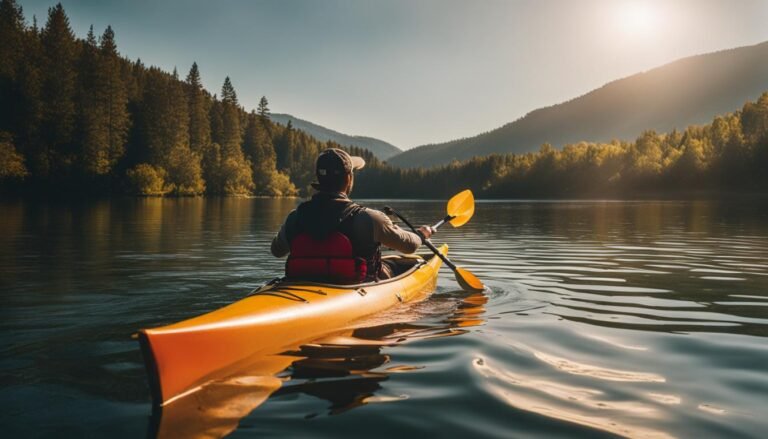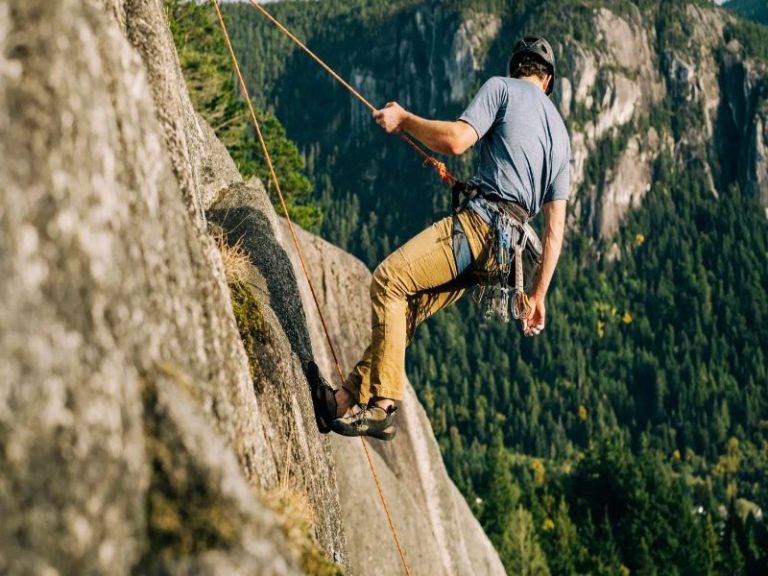Is Kayaking Safe for Non Swimmers?
Are you a non-swimmer considering kayaking? You might be wondering if it’s a safe activity for someone like you. The good news is that kayaking can be enjoyed by both swimmers and non-swimmers. While it’s recommended for first-timers to take a lesson before venturing out on their own, it’s entirely possible to kayak safely as a non-swimmer by taking certain precautions.
Key Takeaways:
- Kayaking can be enjoyed by non-swimmers with proper precautions.
- Lessons are recommended for first-time kayakers.
- Wearing a personal flotation device (PFD) is crucial for safety.
- Choosing stable kayaks and suitable locations is important.
- Confidence in the water can be built over time.
Can You Kayak as a Non-Swimmer?
Yes, you can absolutely enjoy kayaking even if you are a non-swimmer. While knowing how to swim is preferred, being comfortable in the water and wearing a Personal Flotation Device (PFD) can make your kayaking experience safe and enjoyable. The key is to take proper precautions and prioritize your safety at all times.
Kayaking as a non-swimmer requires you to understand the risks and take appropriate measures to mitigate them. The biggest concern for non-swimmers is the risk of drowning, which is why wearing a PFD is crucial. A PFD will keep you afloat in case you accidentally end up in the water and provide you with a sense of security throughout your kayaking expedition.
Moreover, it is highly recommended to kayak with someone who has experience in paddling. This way, you can benefit from their guidance and knowledge, ensuring a smoother and safer kayaking experience. They will be able to assist you in handling the kayak and overcoming any challenges that may arise during your adventure.
Table: Tips for Safe Kayaking as a Non-Swimmer
Here are some essential tips to help non-swimmers enjoy kayaking safely:
| Tips | Description |
|---|---|
| Wear a PFD | Always wear a properly fitting PFD to ensure flotation and safety in the water. |
| Kayak with an Experienced Paddler | Go kayaking with someone who has experience in paddling to safely navigate the waters. |
| Take Kayaking Lessons | Consider taking lessons to learn the basics of kayaking and gain confidence in the water. |
| Choose a Stable Kayak | Select a kayak that offers stability and is suitable for your body type. |
| Consider Outriggers | If needed, add outriggers to your kayak for extra stability and balance. |
| Build Water Confidence | Work on overcoming any fear of the water through gradual exposure and practice. |
| Pick Calm Water Locations | Choose kayaking spots with calm and gentle waters to minimize risks and challenges. |
| Avoid Using a Leash | For safety reasons, it is best to avoid using a leash while kayaking. |
By following these tips and prioritizing safety, non-swimmers can enjoy the thrill and beauty of kayaking without compromising their well-being. Remember to always assess the conditions, wear a PFD, and make informed decisions to ensure a safe and memorable kayaking experience.
Why Are PFDs So Important?
Personal flotation devices (PFDs) are crucial for ensuring kayaking safety, especially for non-swimmers. Whether you’re an experienced kayaker or just starting out, wearing a properly fitting PFD can significantly reduce the risk of drowning in the event of an unexpected swim. Accidents can happen while kayaking, and wearing a PFD provides an extra layer of protection.
According to a study by the American Canoe Association, many kayaking deaths occur due to the failure to wear a PFD. This emphasizes the importance of always wearing one, especially if you’re a non-swimmer. A PFD is designed to keep you afloat and provide buoyancy, even if you find yourself in deep water or facing strong currents.
“Wearing a PFD while kayaking is non-negotiable. It’s your best friend on the water, providing the necessary support and giving you the confidence to enjoy your kayaking adventure,” says Sarah Thompson, an experienced kayaker.
Taking Safety Precautions with PFDs
When it comes to PFDs, it’s important to choose one that is suitable for kayaking and fits you properly. A PFD that is too loose may slip off in the water, while one that is too tight can restrict your movements. Look for a PFD that is approved by the U.S. Coast Guard and follow the manufacturer’s instructions for a secure fit.
Remember, wearing a PFD is not only about having it on; know how to wear it correctly. Fasten the buckles and straps to ensure a snug fit, and make sure the PFD is properly adjusted for your body. Regularly check the condition of your PFD for any signs of wear or damage, and replace it if needed.
By prioritizing safety and wearing a PFD, non-swimmers can enjoy the exhilaration of kayaking while having peace of mind knowing they have the necessary equipment to keep them safe in the water.
| Advantages of Wearing a PFD | |
|---|---|
| 1 | Provides buoyancy, keeping you afloat in case of a swim |
| 2 | Reduces the risk of drowning |
| 3 | Increases confidence and comfort in the water |
| 4 | Offers insulation in cold water |
| 5 | Allows for quick and easy identification in case of emergencies |
Tips for Kayaking for Non-Swimmers
For non-swimmers who want to enjoy kayaking safely, there are several important tips to keep in mind. By following these suggestions, you can enhance your water confidence and have a positive kayaking experience.
- Always wear a properly fitting PFD: A personal flotation device (PFD) is a crucial safety measure for non-swimmers. Ensure that you have a PFD that fits you well and know how to wear it correctly. This will provide you with the necessary buoyancy in case of an unexpected swim.
- Never paddle alone: It’s always safer to go kayaking with a more experienced paddler. They can provide guidance, assistance, and support if needed. Additionally, paddling with a partner can contribute to the enjoyment of the activity.
- Take kayaking lessons: Consider taking kayaking lessons to learn the basics and gain confidence in the water. Professional instructors can teach you proper paddling techniques, safety protocols, and help familiarize you with the equipment.
- Choose a stable kayak: When selecting a kayak, opt for a stable and beginner-friendly model. Look for kayaks that suit your body type and provide good stability on the water. This will help you feel more secure during your kayaking adventures.
- Consider outriggers: If you desire extra stability, consider fitting your kayak with outriggers. These attachments can provide additional balance and prevent tipping, offering reassurance to non-swimmers.
- Work on overcoming your fear: If you have fear or anxiety around water, consider working on overcoming these feelings. Gradually expose yourself to water-related activities, seek support from professionals, and practice relaxation techniques to build your confidence.
- Choose calm water locations: Select suitable kayaking locations with calm waters to minimize the risk of challenging conditions. Avoid strong currents, high waves, or areas with heavy boat traffic, especially when you are still developing your kayaking skills.
- Avoid using a leash: While leashes can be helpful for certain water activities, it is generally advised to avoid using them while kayaking, especially as a non-swimmer. Leashes can potentially entangle and hinder your movements, increasing the risk of accidents.
By following these tips, non-swimmers can kayak safely and enjoy the beauty of the water without compromising their well-being. Remember, your comfort and safety should always be a priority when engaging in outdoor activities like kayaking.
| Tips for Kayaking for Non-Swimmers |
|---|
| Always wear a properly fitting PFD |
| Never paddle alone |
| Take kayaking lessons |
| Choose a stable kayak |
| Consider outriggers for added stability |
| Work on overcoming your fear of the water |
| Pick a suitable location with calm water for your kayaking trips |
| Avoid using a leash while kayaking |
Conclusion
Kayaking can be a thrilling and safe outdoor activity for non-swimmers, as long as the proper precautions are taken. The most important safety measure for non-swimmers is wearing a personal flotation device (PFD), which significantly reduces the risk of drowning. Whether you are a beginner or an experienced kayaker, always prioritize your safety by wearing a properly fitting PFD.
In addition to wearing a PFD, following other safety tips can further ensure a safe kayaking experience. Always paddle with a more experienced kayaker who can guide and assist you throughout the trip. Taking kayaking lessons is also highly recommended, as it helps you learn the basics and gain confidence in the water.
Choosing suitable locations for kayaking is essential for non-swimmers. Opt for calm waters with minimal currents and avoid challenging or unpredictable conditions. It’s also important to pick a stable kayak that suits your body type and consider fitting it with outriggers for added stability.
By taking these safety measures and being mindful of your own comfort level and limitations, non-swimmers can confidently enjoy the beauty of nature and the excitement of kayaking. So grab your PFD, get out on the water, and have a safe and unforgettable kayaking experience!
FAQ
Is kayaking safe for non-swimmers?
Yes, kayaking can be safe for non-swimmers as long as proper precautions are taken, such as wearing a personal flotation device (PFD) and following safety tips.
Can you kayak as a non-swimmer?
Yes, it is possible to kayak as a non-swimmer. While knowing how to swim is preferred, being comfortable in the water and knowing how to float with the help of a PFD is sufficient for kayaking.
Why are PFDs so important?
Personal flotation devices (PFDs) are essential for kayaking safety, regardless of whether you can swim or not. Wearing a properly fitting PFD can greatly reduce the risk of drowning in case of an unexpected swim.
What are some tips for kayaking for non-swimmers?
Some tips for kayaking for non-swimmers include always wearing a properly fitting PFD, paddling with a more experienced kayaker, taking kayaking lessons, choosing a stable kayak, considering outriggers for added stability, working on overcoming the fear of water, picking suitable locations with calm water, and avoiding using a leash while kayaking.
What is the conclusion?
Kayaking can be a safe and enjoyable activity for non-swimmers as long as proper precautions are taken. By wearing a PFD, paddling with more experienced kayakers, and following safety tips, non-swimmers can confidently enjoy the outdoors and the thrill of kayaking.







